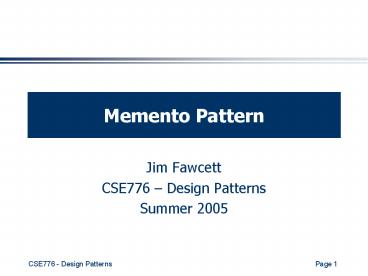Memento Pattern - PowerPoint PPT Presentation
1 / 20
Title:
Memento Pattern
Description:
CSE776 - Design Patterns. Page 1. Memento Pattern. Jim Fawcett. CSE776 ... memory loss, he uses notes and tatoos to compile the information into a suspect. ... – PowerPoint PPT presentation
Number of Views:1215
Avg rating:3.0/5.0
Title: Memento Pattern
1
Memento Pattern
- Jim Fawcett
- CSE776 Design Patterns
- Summer 2005
2
References
- doFactory.com
- http//www.dofactory.com/Patterns/PatternMemento.a
spx - Marc Cliftons Blog
- http//www.marcclifton.com/tabid/99/Default.aspx
- Software Architecture, ETH, Zurich Switzerland
- http//se.ethz.ch/teaching/ss2005/0050/slides/60_s
oftarch_patterns_6up.pdf
3
Intent
- Capture and externalize an objects state without
violating encapsulation. - Restore the objects state at some later time.
- Useful when implementing checkpoints and undo
mechanisms that let users back out of tentative
operations or recover from errors. - Entrusts other objects with the information it
needs to revert to a previous state without
exposing its internal structure and
representations.
4
Forces
- Application needs to capture states at certain
times or at user discretion. May be used for - Undue / redo
- Log errors or events
- Backtracking
- Need to preserve encapsulation
- Dont share knowledge of state with other
objects - Object owning state may not know when to take
state snapshot.
5
Motivation
- Many technical processes involve the exploration
of some complex data structure. - Often we need to backtrack when a particular path
proves unproductive. - Examples are graph algorithms, searching
knowledge bases, and text navigation.
6
Motivation
- Memento stores a snapshot of another objects
internal state, exposure of which would violate
encapsulation and compromise the applications
reliability and extensibility. - A graphical editor may encapsulate the
connectivity relationships between objects in a
class, whose public interface might be
insufficient to allow precise reversal of a move
operation.
7
Motivation
- Memento pattern solves this problem as follows
- The editor requests a memento from the object
before executing move operation. - Originator creates and returns a memento.
- During undo operation, the editor gives the
memento back to the originator. - Based on the information in the memento, the
originator restores itself to its previous state.
8
Applicability
- Use the Memento pattern when
- A snapshot of an objects state must be saved so
that it can be restored later, and - direct access to the state would expose
implementation details and break encapsulation.
9
Structure
10
Participants
- Memento
- Stores internal state of the Originator object.
Originator decides how much. - Protects against access by objects other than the
originator. - Mementos have two interfaces
- Caretaker sees a narrow interface.
- Originator sees a wide interface.
11
Participants (continued)
- Originator
- Creates a memento containing a snapshot of its
current internal state. - Uses the memento to restore its internal state.
12
Caretaker
- Is responsible for the mementos safekeeping.
- Never operates on or examines the contents of a
memento.
13
Event Trace
14
Collaborations
- A caretaker requests a memento from an
originator, holds it for a time, and passes it
back to the originator. - Mementos are passive. Only the originator that
created a memento will assign or retrieve its
state.
15
Consequences
- Memento has several consequences
- Memento avoids exposing information that only an
originator should manage, but for simplicity
should be stored outside the originator. - Having clients manage the state they ask for
simplifies the originator.
16
Consequences (continued)
- Using mementos may be expensive, due to copying
of large amounts of state or frequent creation of
mementos. - A caretaker is responsible for deleting the
mementos it cares for. - A caretaker may incur large storage costs when it
stores mementos.
17
Implementation
- When mementos get created and passed back to
their originator in a predictable sequence, then
Memento can save just incremental changes to
originators state.
18
Known Uses
- Memento is a 2000 film about Leonard Shelby and
his quest to revenge the brutal murder of his
wife. Though Leonard is hampered with short-term
memory loss, he uses notes and tatoos to compile
the information into a suspect.
19
Known Use of Pattern
- Dylan language uses memento to provide iterators
for its collection facility. - Dylan is a dynamic object oriented language using
the functional style. - Development started by Apple, but subsequently
moved to open source.
20
Related Patterns
- Command
- Commands can use mementos to maintain state for
undo mechanisms. - Iterator
- Mementos can be used for iteration.































